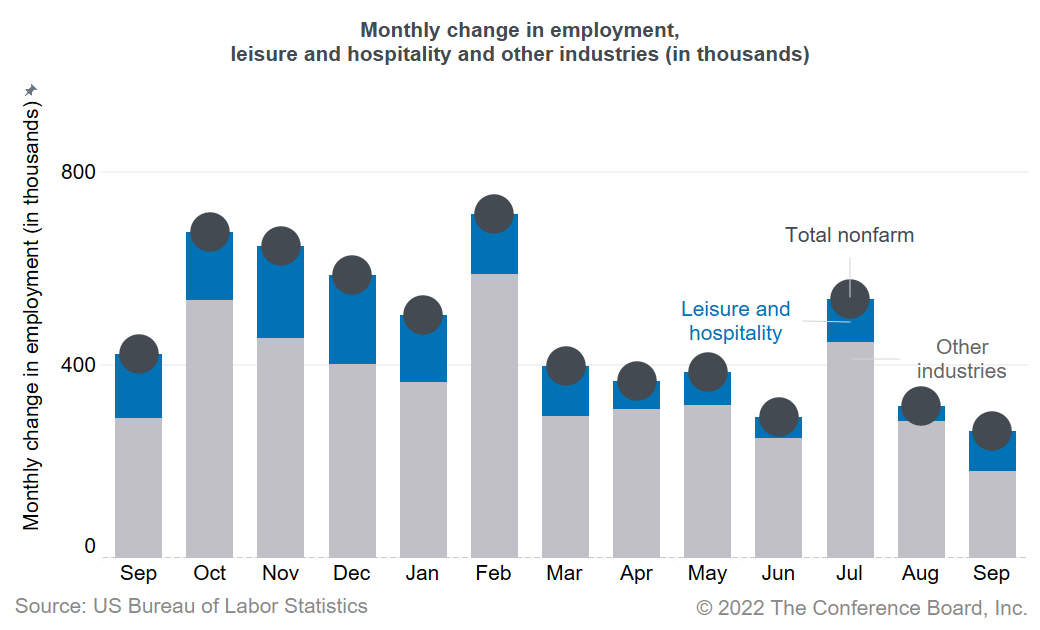
Today’s jobs report showed moderating job gains, with 263,000 jobs added in September 2022, after an increase of 315,000 jobs in August. While this is still a robust rate of employment growth, it is well below the average of 420,000 added per month so far in 2022. Softer job gains were expected amid a weakening economy, the Federal Reserve’s rapid interest rate hikes, and the recovery most industries have already seen from pandemic-induced job losses. With the number of job openings—an important leading indicator of hiring—already on the decline, September’s softer jobs report is another sign that the labor market is cooling. The pace of hiring is expected to slow further as the end of 2022 approaches. The unemployment rate fell to 3.5 percent in September 2022, down from 3.7 percent in August. The labor force participation rate ticked down to 62.3 percent, from 62.4 percent in August. Job gains were visible in most industries. Leisure and hospitality added another 83,000 jobs, with notable gains also seen in health care and social assistance (75,400), professional and business services (46,000), manufacturing (22,000), and construction (19,000). Temporary help services—a leading indicator for hiring—continued to add jobs (27,200), signaling that there may still be potential further, albeit slower, job gains ahead. The labor market remains very tight with average hourly earnings still elevated at 5 percent growth over the past year. However, there are signs that the labor market is cooling. The number of job openings has fallen 15.2 percent since its peak in March 2022; quits remain high but are also down by 6.5 percent since March 2022. The worst of labor shortages may be behind us for now. Further easing of recruitment and retention difficulties can be expected over the next months if the labor market indeed continues to cool. At the same time, there are no clear signs yet of increasing layoffs. This could change in 2023 with the growing likelihood that the US will fall into recession. Still, the unemployment rate is currently projected to only rise to about 4.5 percent in 2023, still quite low in historical context. With the recession projected to be short, job losses may be relatively small. Furthermore, companies have had difficulties over the past year attracting and retaining workers and may therefore avoid implementing layoffs. Altogether, this means that labor shortages may ease over the coming year but are unlikely to disappear.Job Growth Moderates in September, with Further Cooling Expected
Commentary on today’s U.S. Bureau of Labor Statistics Employment Situation Report

March Payrolls: The Calm Before the Tariff Storm
April 04, 2025
February Jobs Report Hints at Growing Uncertainty
March 07, 2025
Stability Underneath January’s Noisy Jobs Report
February 07, 2025
Q4 ECI Wage Deceleration Slows
February 07, 2025
Robust Job Gains Close 2024
January 10, 2025
November Job Gains Rebound from Disruptions
December 06, 2024
Charts
Preliminary PMI indices show no change in weak DM growth momentum in November
LEARN MORECharts
Members of The Conference Board can access all underlying data of the Job Loss Risk Index by Industry in this Excel workbook.
LEARN MORECharts
While a US recession appears to be imminent, it will not look like any other in recent history.
LEARN MORECharts
CEOs’ views of current and future economic conditions remain pessimistic as they prepare for near-inevitable US and EU recessions.
LEARN MORECharts
The US economy appears to be on the precipice of recession.
LEARN MORECharts
Measure of CEO Confidence declined for the fifth consecutive quarter in Q3 2022 and has hit lows not seen since the start of the COVID-19 pandemic in 2020.
LEARN MOREPRESS RELEASE
Survey: In 2024, CEOs Are Most Worried About a Recession & Inflation, But S…
January 10, 2024
PRESS RELEASE
As Labor Day Approaches, HR Leaders Say Hiring
August 29, 2023
IN THE NEWS
CEOs Are Predicting a Mild Recession in the U.S.
June 01, 2023
PRESS RELEASE
Global Productivity Growth Set to Disappoint Again in 2023
May 17, 2023
IN THE NEWS
Dana Peterson on Why Recession is Likely in 2023
April 20, 2023
PRESS RELEASE
Which Industries Will Start Shedding Jobs?
April 05, 2023
